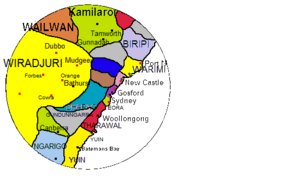Birrbay facts for kids
The Birrbay people, also spelt Birpai, Biripi, Birippi and variant spellings, are an Aboriginal Australian people of New South Wales. They and share a dialect continuum with the Worimi people.
Contents
Language
The Gathang language (aka Gadjang or Worimi) is the speech of the Birrbay centred in Port Macquarie. Birpai is spelt Biripi in southern areas, such as Taree. Gathang was a community language spoken by the six tribes of the Worimi when required to meet. W. J. Enright found four elderly speakers of Gathang at Wauchope in 1932.
Country
Birbay are the traditional owners of some 2,800 square miles (7,300 km2) of Mid North Coast land, from Gloucester eastwards to the coast where the Manning River debouches into the Pacific at Taree. They were mainly located north of the Manning, and on the Forbes, Hastings (Dhungang) and Wilson rivers.
Social organisation
The Birrbay, according to A. R. Radcliffe-Brown, had no moieties, but did divide their hordes into four intermarrying groups, 4 male phratries:
- Wombo
- Kurraboo
- Wirraw
- Murrong
marrying into four female groups:
- Gooran
- Karragan
- Wangan
- Wirragan.
Traditions differ as to whether the Birrbay alternated between the coast and the hinterland seasonally. According to one tradition, they were divided into two distinct groups: inland women being called Winmurra and those of the coast Mari. The northern Birrbay alternated between inland and coastal camps according to the seasons, heading to locations that would provide best food sources. The modern families quite often still follow these protocols when the modern world allows.
An annual reunion of the MoB is held on the northern side of the hastings river in October. With descendants attending from far and wide, numbers for these group gatherings continue to increase annually, being held in a culturally significant location known in modern parlance as the coal wharf in contrast to assertions of near extinction claimed by John Heath in his recently released book Birrpai. Beyond the lens of Thomas Dick.
The Birrbay also had personal totems, called mari. The shark, dolphin and stingray are among the main totems of the clans.
Murrawin ceremony
The Birrbay practised a form of ceremony known as Murrawin, found also among the Dunghutti and Gumbaynggirr peoples. It was described by R. H. Mathews in 1900. Unlike other rites, this did not require the presence of entire communities: two or three adjoining tribes would meet, choose initiated men from among each, and send them into the bush. They would select a spot several miles away, clear it, and create a 20-foot diameter circle on level ground with banked earth. There they would make bullroarers (gheewarra/guarra, according to the dialect) and return to the main camp. Over the following nights, once some elders had set up another site hundreds of yards away, whirl the bullroarers, while chanting incantations, and strike coolamons rhythmically with a nulla nulla. Gradually, the initiated men trickle over to this thoorapee site until all are gathered in. At this point, a slanging match is started as each tribe hurls invectives at another. The morning after, the whole tribal assembly shifts camp, and women and the young are separated from the men, who then file off, clicking their boomerangs, as they make their way to the ceremonial ring prepared several days earlier, where they dance.
History of contact
Birrbay oral histories tell of the massacre of about 300 people around 1826 at Blackmans Point. There is no single written account, but the diary of Henry Lewis Wilson, who oversaw convicts in the area, relates that after two convicts sent to work at Blackmans Point were killed by Indigenous men, a party of soldiers "got round the blacks and shot a great many of them. The offending soldiers were sent to Sydney to be tried, but managed to escape punishment.". Historian Lyndall Ryan, after finding further corroborating written accounts, thinks that the Blackmans Point event referred to by Wilson involved around 20 people, but other massacres in the area may have caused the deaths of up to 300 people. Two or three of the massacres will be included in the official list of colonial massacres being compiled by the University of Newcastle.
The area around Taree was first settled by a naval man, William Wynter, who took up a selection of 2,560 acres (1,040 ha) there in 1831. Wynter appears to have had very amicable relations with the Birrbay, something inferred by the fact that his son William, who grew up among the Birrbay, was allowed to go hunting with them, and learnt their language. This is thought to bear witness to the peaceful character of the Indigenous peoples themselves. Three years later cedar-cutters were establishing camps along the Manning river.
The highland areas and the Falls country around the Manning and Hastings rivers were still sufficiently wild to serve the Aboriginal outlaw Jimmy Governor as a sanctuary at the turn of the 20th century.
Alternative names
Tindale gives the following names:
- Biripi
- Birippi (?)
- Birrapee
- Birripai
- Birripi
- Bripi
- Brippai
- Waw-wyper
AIATSIS notes the following synonyms:
Birbay, Biribai, Biribi, Biripi, Birippi, Birpai, Birpay, Birrapee, Birrbay, Birripai, Birripi, Bripi, Brippai, Gathang, Kattang, Waw wyper, Worimi
Notable people
- Josh Addo-Carr, rugby league footballer
- Latrell Mitchell, rugby league footballer
- Jade North, Australian soccer player, who revealed his identity after years of hiding it, by tattooing "Biripi" on his arm
- Nikita Ridgeway, tattoo artist and graphic designer
- Ella Simon, historic figure, leader, autobiography Through My Eyes
- Kyah Simon, international soccer player
Some words
- belbora/baalbora. (place of evil, name for a massacre site)
- bellbouri. (type of tea-tree)
- bucker (knee).
- groki. (toad fish)
- kimbriki (water reeds)
- koribar. (white cedar)
- kundibakh. (wild apples)
- kureeki (ferns)
- tareebin (native fig fruit, hence the name Taree, where it was abundant).
- tigerah. (ironbark)


